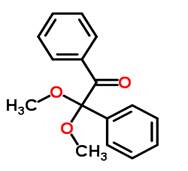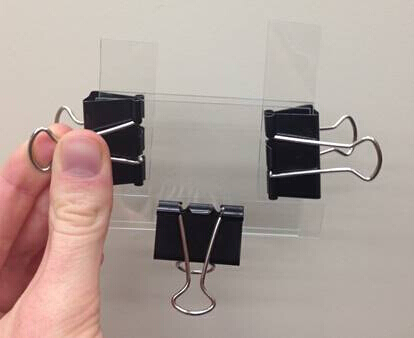プレゲル溶液は、1000μl試験管で作成されました。材料、重合における役割および添加量は表1にリストされている。
| 材料 |
目的 |
構造 |
モルパーセント |
| 2,2-ジメトキシ-2-フェニル-アセトフェノン(DMPAP) |
無料の読み取りイニシエーター(フォトイニシエータ) |
 |
0.0012 |
| 2-ヒドロキセチルメタクリレート
(ヘマ)
|
ポリマー骨格 |
 |
21.2121 |
| テトラエチレングリコールジメタクリレート(TEGDMA) |
架橋器 |
 |
3.0303 |
| エチレング リコール
(EG)
|
溶媒 |
 |
75.7576 |
表 1.ヒドロゲルプレゲル成分は、ヒドロゲルフリーラジカル重合におけるそれらの役割、化学的2Dポリマー構造およびプレゲル溶液に添加される量である。
合成
- ヒドロゲル合成を開始する前に、合成金型を2枚のガラススライドと3枚、520ミクロンの厚いポリオレフィンシートスペーサーから組み立てた。この構成は、図 6に示すように、バインダー クリップによってまとめて保持されました。大きなガラススライドは数ミリメートルでオフセットされ、プリゲル溶液を金型にパイプで突き出すためのチャネルを作成しました。
- ヒドロゲル合成を開始する前に、1000μl試験管、表1に記載の化学物質、クリーンチップを有するマイクロピペット、および設定金型(図6)を得る。すべての作業は、適切な個人用保護具(PPE)とヒュームフードで行う必要があります。PPEには安全メガネまたはゴーグル、ラボコート、保護手袋が含まれています。

図6:ハイドロゲル合成金型は、2枚のガラススライドから作成され、スペーサーとして520ミクロンの厚いポリオレフィンシートの3つのストリップ、および大きなバインダークリップから作成された。
- 0.0012モルパーセント2,2-ジメトキシ-2-フェニルアセトフェノン(DMPAP)、固体光分光子(光によって開始されるフリーラジカル開始剤)を試験管に最初に追加します。
- 21.2121モルパーセント2-ヒドロキセチルメタクリレート(HEMA)、バックボーン分子、および3.0303モルパーセントテトラエチレングリコールジメタクリレート(TEGDMA)を加え、クロスリンク分子を試験管に、毎回新しいピペットチップを使用します。TEGDMAは、ポリマー鎖をネットワークポリマーに接続することにより、フリーラジカルの存在下でHEMA鎖を化学的に架橋します。
- 均質な溶液が得られるまで、渦機を使用して溶液を混合します。
- ブロモクレスルパープルの0.25グラムを測定し、溶媒75.7576モルパーセントエチレングリコール(EG)を使用して溶液中にすすすします。顔料は、視聴目的(ヒドロゲルは透明である)のみを対象としており、EGは開始フリーラジカル開始剤を溶解する溶媒として機能し、ヒドロゲルを柔軟に保ちます。
- 色素が完全に溶解し、溶液が均質になるまで、渦機を使用して溶液を混合します。
- マイクロピペットを使用して、マイクロピペットの先端を大きなガラススライドのオフセットエッジに位置合わせし、プリゲル溶液を金型の中央に均一に注入して、溶液を金型に堆積させる。
- UV発光懐中電灯(Warson SK66)の下に金型5センチメートルを置き、金型を1分間照射します。UV光は、開始剤種の結合を切断し、それらをフリーラジカルに変え、ポリマーおよび架橋分子を攻撃することができる。完全にネットワーク化された場合、ヒドロゲルはゼリー状の一貫性を持つゴム固体でなければなりません。
- ライトから金型を取り外し、金型構成を分解します。ガラススライドからヒドロゲルを取り除きます。
- ヒドロゲルの両面を脱イオン水ですすいで、未反応の化学種やオリゴマーを製品から除去します。
- 様々な紫外線暴露時間が架橋および膨潤能力の程度にどのように影響するかを特徴付けるために、この手順はステップ9を変化させながら繰り返すことができる。特性評価のために、溶液を1分間、1.5分および5分間UV光に曝露し、合計3つのヒドロゲルを生成した。
評価
ヒドロゲルの膨潤度は、乾燥、水和、その後、ポリマーを再乾燥することによって計算することができる。
- 完成したヒドロゲルをイソプロピルアルコールなどのアルコール入りの容器に入れ、完全に水没させます。アルコールがヒドロゲル内のすべてのエチレングリコールを置き換えたときに、4〜8時間アルコホールに残します。
- アルコールからヒドロゲルを取り出し、開いた状態で30分ほど乾燥させます。アルコールは水や溶媒よりも速く蒸発し、ヒドロゲルがその構造を維持することを可能にする。
- 乾燥したヒドゲルの重さを量ります。
- ヒドロゲルを少なくとも30分間、完全に膨潤するまでDI水中に沈めます。水からジェルを取り出し、軽く拭いて重くします。
- 腫れたポリマーの重量

 であり、乾燥ポリマー
であり、乾燥ポリマー の重量である:、という式を使用して膨潤度を計算します。
の重量である:、という式を使用して膨潤度を計算します。






 であり、乾燥ポリマー
であり、乾燥ポリマー の重量である:、という式を使用して膨潤度を計算します。
の重量である:、という式を使用して膨潤度を計算します。












